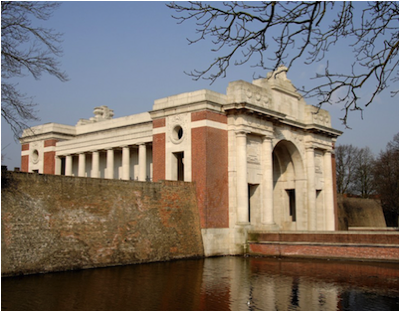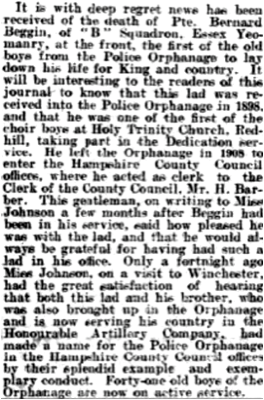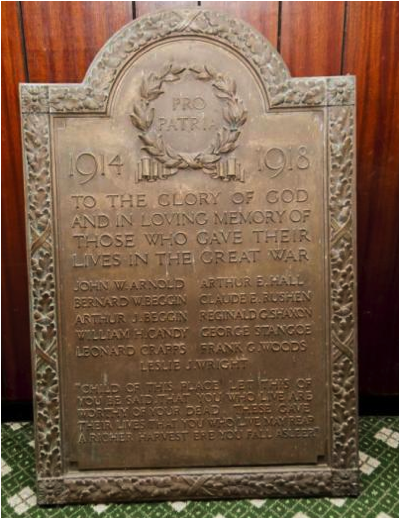Bernard William Beggin was the orphaned son of a Hampshire police officer who had died at a Royal Review. He worked for Essex County Council, joined the army, and was killed in action in the Second Battle of Ypres in May 1915. His brother was killed in the war.
Bernard William Beggin (sometimes ‘Biggin’) was born in Sutton Scotney near Winchester, Hampshire in 1893, the son of the Hampshire police officer Bernard Beggin and Annie Beggin. They had married in London in 1890.
Bernard’s siblings were: Annie Maud Beggin (1891-1963), James Arthur Beggin (sometimes ‘Arthur James’) (1894-1916), Reginald George Beggin (1896-1949) and Margaret Beggin (born 1897).
BEGGIN, BERNARD WILLIAM,
Trooper, B Squadron, Essex Yeomanr
Major Buxton, who was now in command of the Essex Yeomanry, despatched a man with a message to get into touch with the Royal Horse Guards on the right, but this messenger was instantly killed. Any movement on the part of anybody on the right of this line was impossible, and many were killed or wounded in attempting to take ground in any direction. A very heavy bombardment with great accuracy was, by this time,

Bernard’s father died in Hampshire in tragic circumstances in 1897, aged 33. A local newspaper reported his death under the headline ‘A sad case.’
Following that tragedy Bernard’s family broke up. Bernard’s mother appears to have returned to London, along with her youngest two children, while Bernard and his brother James were sent to the Provincial Police Orphanage at 117 London Road, Reigate, Surrey - Bernard arriving in May 1898, aged five, followed by James in May 1900. Bernard was recorded there by the 1901 census. Meanwhile his widowed mother was recorded living with her parents and her children Reginald and Margaret in Fulham, and eldest sister Annie was at the Female Orphan Asylum at Beddington in Surrey.
In 1905 Bernard won the annual prize at the orphanage for ‘obedience.’ At the same time his brother James won the prize for ‘Junior Scripture.’
The 1911 census listed Bernard, aged 17, lodging at 30 Stockridge Road in Winchester. He was a clerk for Hampshire County Council, as was his 16 year-old brother James, having gone to work there in 1906. Their elder sister was a kitchen maid at Hove Vicarage in Sussex; their younger brother Reginald was at Reedham Orphanage in Surrey; and their younger sister was at an institution in Surrey.
In the period between the 1911 census and the start of the war Bernard moved to Essex to work for Essex County Council.
He enlisted into the army at Colchester on 5th October 1914. He served with the Essex Yeomanry as Trooper 1350, and landed in France on 25th March 1915.
The Essex Yeomanry had assembled at Ipswich, Suffolk after mobilisation on 7th August 1914, moving to Melton near Woodbridge, Suffolk soon afterwards. At the end of November 1914 it had crossed from Southampton to Le Havre, before proceeding to the Hazebrouck area in northern France, close to the Belgian frontier. There it formed part of the 8th Cavalry Brigade, itself part of the 3rd Cavalry Division and afterwards, in early February 1915, had moved north-eastwards and gone into the line east of Ypres in Belgium.
By the time Bernard joined the regiment at the end of March 1915 it was back in the Hazebrouck area. April 1915 was spent mostly in training, with lectures in trench warfare. The weather turned fine after the constant rain that had fallen in the winter months.
At the end of April 1915 the Germans launched an ultimately unsuccessful attempt to capture Ypres (the Second Battle of Ypres), involving the first use of poison gas on the Western Front. The battle was to continue until 25th May 1915 and during that period the Essex Yeomanry suffered many casualties.
On 12th May 1915, after dark, the regiment, numbering 302 men in all, was ordered to dig a communication trench at Bellevarde, near Potijze, east of Ypres. The task had to be abandoned before daybreak on 13th May 1915 after casualties became too frequent. A post-war history of the Essex Yeomanry reported:
“At dawn, on May 13th the Regiment marched to rejoin the remainder of the Brigade [in support trenches] and the preliminary stages of the German attack began....Very heavy shelling commenced at 4 a.m. The bombardment was at first directed on the front line on a breadth of about one mile, held by the 6th and 7th Cavalry Brigades and the 2nd Dragoon Guards. A dense cloud of smoke hung over the whole area; buildings and trenches alike were demolished beyond recognition.
At about 6 a.m. the enemy brought his barrage over the line held by the 8th Cavalry Brigade, and by 7 a.m. the 1st and 2nd Life Guards were forced to retire through the lines held by the 8th Brigade. The Essex Yeomanry were in the support trench just west of the Potijze-Verlorenhoek road on the north-east edge of Potijze Chateau garden. At about 9 a.m. a message was received through the telephone from the Front line saying ‘Front line absolutely intact’, but all the same it was evident that a retirement was in progress.
At mid-day Colonel Deacon was informed that the Royal Horse Guards and 10th Royal Hussars had been moved forward; consequently the Essex Yeomanry were moved into the trenches on the east of the Potijze-Verlorenhoek road, which had been occupied the Blues and the 10th Hussars.
At about 1.30 p.m. Brigadier-General Bulkeley Johnson, A.D.C., who had established his Brigade Head Quarters in the Chateau Gardens, sent for Lieut.-Colonel Deacon and as a result of the interview the Squadron leaders were informed by Colonel Deacon that a counter-attack was to be undertaken at 2.15 p.m., in order to regain the front line which had been occupied by the enemy.
The Brigade for the purpose of the attack was disposed as follows: - Royal Horse Guards on the right, 10th Royal Hussars on the left, and A. Squadron, under Captain J. O. Parker, in support. The Regiment was to move in 10 minutes and take up a line on the right of the 10th Hussars. The 10th Hussars, it was thought, were in some trenches half way up the rising ground with their right near a White Farm, and their left on the road.
Colonel Deacon gave orders for Major Buxton to take two scouts with him, and report to Lieut.-Colonel E. R. A. Shearman commanding the 10th Hussars to the effect that the Essex were coming up on is right. Major Buxton came under heavy rifle fire from the direction of the White Farm, but found Colonel Shearman near the road. Major Buxton delivered the message, and Colonel Shearman pointed out to Major Buxton the trenches which were to be his objective, and said ‘That is the trench that I am going to take. I shall do it with the greatest ease, there is no doubt about it whatever.’
The Essex Yeomanry were by this time running towards the right of the 10th Hussars, led by Major Roddick and Captain E. A. Ruggles-Brise; the men had bayonets fixed, and cheered as they ran for their objective, Major Roddick was killed almost instantly. Captain Ruggles-Brise continued gallantly at the head of his Squadron.
Lieut.-Colonel Shearman realising that it was not yet the time to deliver the attack, told Major Buxton to do his utmost to stop the advance of the Essex; this he was able to do, and the Essex lay down on the right of the 10th Hussars. At this moment a group of Germans fled from the positions they were holding, and someone holloaed ‘Tally ho! Yonder they go’. As a response to the view holloa the whole line, the Essex on the right and the 10th Hussars on the left, rose as one and rushed the hill. The going was deep, but no one halted until the trench was reached as were also a series of holes which the line degenerated into on the right. Very heavy casualties were suffered in both regiments....The objective, however, was gained, and held under very trying conditions.
A large amount of German equipment was found in the line, as was also coffee and sausages. Some prisoners were taken. The line now held was at once consolidated. Captain E. A. Ruggles-Brise and Lieut. R. A. Thomson, with very few men, put up a splendid resistance and held on to some ruins just to the right and in front of our line.


concentrated on the line now held, and a large body of the enemy moved forward from the Verlorenhoek hill.
A small dark red flag was placed in a trench by the enemy about 150 yards in advance of our line; this was doubtless a signal for the enemies’ artillery to ascertain the position of their front line. The rain fell heavily, and the mud was indescribable, rendering rifles unserviceable in a very short time; in fact, these had by now become almost completely ineffective. After 2 hours a message came through from the 10th Hussars to the effect that they were retiring behind the crest and filing out of the left end of the trench.

Captain E. A. Ruggles-Brise and Lieut. R. A. Thomson were still gallantly holding on with their small group of men at and about the ruined cottages, and communication with them was impossible. Their only hope of falling back was to wait till after dark. Two of their officers were killed....A general retirement behind the crest was then undertaken, to a position on the reverse slope of the hill, about 600 yards in rear of the advanced position. This line was held until about 6 p.m.
The general line was taken up by the 2nd Dragoon Guards on the left of the 10th Hussars had been maintained throughout, and their assistance by thus maintaining their position contributed much towards the result of the day’s fighting. At about 6 p.m. orders were received for the Essex Yeomanry to concentrate at a house near the G.H.Q line on the main road.
The 10th Hussars took up a support line and then the Essex Yeomanry moved into the G.H.Q. line. It was here that the Squadrons rallied under Major A. Buxton, now commanding the Regiment. Captain E. A. Ruggles-Brise and Lieut. R. A. Thomson and about 6 men returned, having remained the whole time holding on to the positions which they had captured, Wounded men also kept coming in under cover of the darkness. Many Officers and men were missing, many were known to be killed and wounded.
During the day the Essex Yeomanry had suffered 51 killed, including its commanding officer, 19 missing and 91 wounded - more than half of its number. One of the fatalities was Bernard, killed in action. He was aged 21.
Bernard has no known grave and is commemorated on the Ypres (Menin Gate) Memorial, on the Civic Centre Memorial, Chelmsford, on the Essex County Council war memorial at County Hall, Chelmsford (which shows he was employed in the ‘small holdings department’), the Essex Yeomanry Memorial at Chelmsford Cathedral, and the Provincial Police Orphanage Great War Memorial.
A Surrey newspaper reported Bernard’s death under the headline ‘Police orphanage boy killed at the front’ (see above, right).
The Commonwealth War Graves Commission has an alternative date of death of 11th May 1915 when the regimental war diary shows the Essex Yeomanry to have been at rest at Brielen.
Bernard was entitled to the 1914-15 Star, British War Medal, and Victory Medal.
Sadly Bernard’s death was not the last tragedy to befall the family - in 15th November 1916 Bernard’s brother James was killed in action while serving with the Honorable Artillery Company.
After the war his mother was resident at Selwood Lodge, Elm Place, Fulham Road in London. She died in London in 1928.

In late November 2013 the Sutton Guardian newspaper reported that an unidentified war memorial (pictured) had been found dumped at the Belmont Conservative Club. The memorial included Bernard Beggin’s name (and that of his brother) and researchers found this webpage and from it deduced that the memorial had come from the Provincial Police Orphanage. Click here to see the story in the Sutton Guardian.
Acknowledgements to Ian Miller
140215